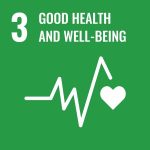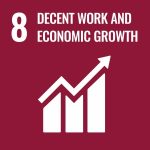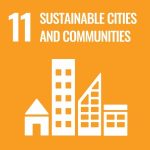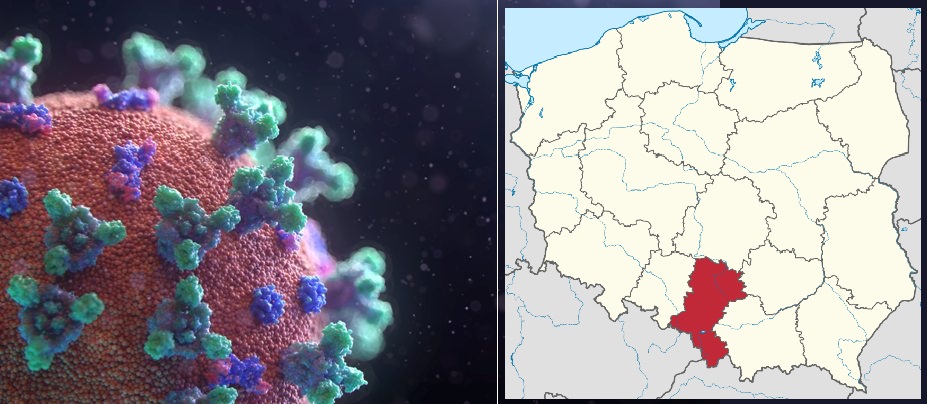The article on COVID-19 epidemic in Poland, with particular focus on the Silesian Voivodeship, written by academics from the Institute of Social and Economic Geography and Spatial Management at the University of Silesia – Assoc. Prof. Robert Krzysztofik, Professor of the University of Silesia, Assoc. Prof. Iwona Kantor-Pietraga, Professor of the University of Silesia and Dr. Tomasz Spórna – was published in ‘Eurasian Geography and Economics’.
The scientists have analysed the conditions that put the Silesian Voivodeship in the centre of media interest with reference to the spread of coronavirus in Poland. Moreover, the four most important factors affecting the heterogeneous spatial distribution of COVID-19 incidence recorded in the region have been discussed. These factors include urban shrinkage, trans-industrialism, significance of hard coal mining and region polycentricity.
The article entitled ‘Spatial and functional dimensions of the COVID-19 epidemic in Poland’ is available on www.researchgate.net.
 |
The University of Silesia in Katowice supports the implementation of UN Sustainable Development Goals |
 |
 |
 |
The research of Assoc. Prof. Robert Krzysztofik, Professor of the University of Silesia, Assoc. Prof. Iwona Kantor-Pietraga, Professor of the University of Silesia and Dr. Tomasz Spórna address the implementation of UN Sustainable Development Goals.
Goal 3 – good health and well-being
The presented results concern the analysis of coronavirus infections in the Silesian Voivodeship and factors affecting the growth of incidence confirmed with tests in this region.
Goal 8 – decent work and economic growth
Goal 11 – sustainable cities and communities
The authors of the article have also emphasized the significance of trans-industrialism and urban shrinkage, as well as other effects of economic changes that may be observed in the Upper Silesia and Zagłębie Dąbrowskie.
Contact:
Assoc. Prof. Robert Krzysztofik, Professor of the University of Silesia | Faculty of Natural Sciences – robert.krzysztofik@us.edu.pl
The first case of coronavirus in Poland was confirmed at the beginning of March 2020. In May the highest increase of COVID-19 incidence began to be recorded in the Silesian Voivodeship, whereby the epicentre of the disease spread was located in the coal mines. Although fossil fuels are an inherent part of the region’s traditions, and a majority of Poles still associate Upper Silesia and Zagłębie Dąbrowskie with coal mining, intensive efforts aimed at gradual social and economic transformation of this part of our country have been under way for several dozen years, taking into consideration e.g. the importance of climate policy adopted in Europe.
Therefore, one of the essential issues is the question why the Silesian Voivodeship is referred to as the epicentre of coronavirus epidemic in Poland and whether the presence of mining industry may really be of crucial importance in this regard. This subject was undertaken by scientists from the Institute of Social and Economic Geography and Spatial Management at the University of Silesia in Katowice, and their first research results have just been published in ‘Eurasian Geography and Economics’.
Fusion Medical Animation, Unsplash | TUBS, Wikipedia | CC BY-SA 3.0
Mining industry
The word miners has recently appeared in the media most often next to Silesia and coronavirus. Coal mines have become the main location of COVID-19 spread, which immediately translated into the spatial image of incidence distribution across the province.
‘We have recorded the most cases of coronavirus infection in the coal mining towns and cities, as well as in the places with the high concentration of people employed in the coal mining industry sector. However, we cannot forget that, similarly to the whole country, the places with intensified incidence also include hospitals and residential homes’, says Assoc. Prof. Robert Krzysztofik, Professor of the University of Silesia, Head of the Institute of Social and Economic Geography and Spatial Management at the University of Silesia in Katowice, co-author of the research.
‘In the case of the Silesian Voivodeship, a high growth of infection cases was initially reported in two cities, namely Bytom and Sosnowiec, while the number of confirmed cases in the capital of the voivodeship, i.e. Katowice, was relatively small’, he adds.
The working culture inherent in coal mining, as well as the whole coal mine infrastructure, is also important in this case. When subsequent restrictions and limitations were introduced in Poland together with the epidemic spread, they had the least impact on the coal mining industry and industrial production sector.
‘We could probably talk for a long time about the causes of the decision to continue coal mine operation. It was determined by both economic and (probably) political factors. Does this mean, however, that this economy sector will not be affected by the negative effects of the pandemic? Definitely not’, comments the expert.
He also adds that it is worth realising the nature of work in coal mining. Despite the implemented recommendations and safety rules being followed, the shared bathhouses and small lifts (commonly known as szola) used by miners for transport contributed to the spread of the disease. The first confirmed cases of COVID-19 in the Silesian mines occurred in April, while a sudden growth of the number of positive results of coronavirus tests was recorded in May (3,200 confirmed cases as of 22 May, according to the authors of the article).
First of all, the growing number of diagnosed incidence cases resulted in a temporary closure of specific coal mines, including ‘Murcki-Staszic’ in Katowice, ‘Bobrek’ in Bytom and ‘Sośnica’ in Gliwice. Secondly, it was recommended to carry out mass tests for the presence of coronavirus among the coal mining industry employees, which had previously been conducted in Poland only for health care staff.
‘The media attention paid to the Silesian Voivodeship in the context of coronavirus spread in Poland, including, for example, the absurd comparisons to the Italian city of Bergamo, has become quite a challenge for the region and its inhabitants. We have heard about the cases of refusing accommodation services for people from our Voivodeship. And we have a certain paradox here. If there is a single professional group in Poland that has already gone through the epidemic, at least partly and ‘officially’, it is precisely the coal miners. It is worth remembering that we are one of three regions where the highest number of tests has been carried out (source: www.gov.pl – Polish language)’, says Assoc. Prof. Robert Krzysztofik.
‘Moreover, if we look at the relations between the number of population and the percentage distribution of the recorded incidence (including ‘symptomless’), it turns out that we do not significantly deviate from what has been noticed in other provinces’, he adds.
There is a reason why coal mining, although most frequently mentioned in the context of epidemic situation in the Silesia Voivodeship, is not the only factor behind the spatial diversification of confirmed coronavirus infection cases in the region. The other factors contributing to the disease spread, which are frequently mentioned in the media, include the proximity of cities and density of population.
Polycentricity
The authors of the article have emphasized the dominating urban type of settlement in the region, i.e. the significant spatial proximity of cities. The conurbation, which is inevitably related to high population density, could theoretically foster a more intense coronavirus spread. The Silesian Voivodeship has been at the top of the list in respect of the number of people per 1 km2 in Poland for years (precisely 368 people/km2, according to the statistics of Statistics Poland of 2019).
However, research has shown that the key factor affecting the course of epidemic spread is the spatial distribution of population which is most exposed to incidence, rather than population density and size of cities.
Therefore, the demographic structure and current state of the society in a particular region are of crucial importance for undertaking action to stop the pandemic spread.
‘Here we are raising a very important issue, which has been highlighted in the media many times. To put it simply, we can say that the highest number of recorded cases is reported in the place where the most tests have been performed. And the biggest number of tests are carried out in the social and professional groups with the highest likelihood of coronavirus infection. In case of COVID-19 in the Silesian Voivodeship, another factor contributing to the occurrence of larger epidemic outbreaks is the conditions related to the so-called urban shrinkage phenomenon and the process of trans-industrialism’, says the scientist from the University of Silesia.
Trans-industrialism
To reflect the nature of the process of economic changes, which have been taking place in the Upper Silesia and Zagłębie Dąbrowskie for years, scientists came up with the term of trans-industrialism several years ago. On the one hand, the mining industry still dominates in certain cities of the region, such as Ruda Śląska and Knurów. On the other hand, a significant part of the region can be defined as post-industrial, with various paths of transformation taken. In some of the cities we can see the strengthening of the modern services sector or reindustrialisation, while economic stagnation prevails in others.
‘This means that, in practice, it is a kind of economic patchwork. The Silesian Voivodeship and Katowice conurbation are not homogeneous, which is why the spatial distribution of recorded COVID-19 incidence is highly diversified. The above-indicated relationships are not accidental, as we have tried to prove in our publication. Therefore, we took into account the significance of other factors, including the previously discussed mining industry, as well as polycentricity and the urban shrinkage phenomenon, which we will consider in a moment’, explains the co-author of the research.
Trans-industrialism allows to capture the dynamic character of the constantly occurring changes and subsequent, gradual stages of region transformation; thus, it may be more important for the coronavirus spread than expected.
Urban shrinkage
As explains Assoc. Prof. Robert Krzysztofik, the above-mentioned factors are strongly correlated and affect the occurrence of another, possibly most significant condition in the context of the spatial distribution of the recorded coronavirus incidence in the Silesian Voivodeship, Namely the urban shrinkage process, which we have already referred to before.
‘Let me emphasize that the loss of inhabitants itself does not necessarily prove the phenomenon that we are talking about. This definitely does not apply to Katowice and Tychy, which are now depopulating, as we know, but I wouldn’t say that they are shrinking‘, says the scientist.
‘This is due to the fact that the depopulation process is accompanied by many different, frequently correlated factors: social, spatial and economic. In this context, we can talk about suburbanisation, low fertility and birth rate, ageing of population, certain lifestyle, poverty, negative perception of urban space, lack of development perspectives, ineffective management, growing unemployment level, social exclusion, etc.’, specifies the scientists.
‘In our opinion, the cities that are affected by the shrinkage phenomenon, with all its effects, require special attention, also in the pandemic age’, he sums up.
The above analyses, therefore, show that it is necessary to take into account many different factors affecting the uneven spread of coronavirus in the Silesian Voivodeship, as well as try to answer the question why the highest growth of the number of infections (confirmed with tests, which is worth emphasizing again) is currently observed in this particular region.
| Małgorzata Kłoskowicz|






